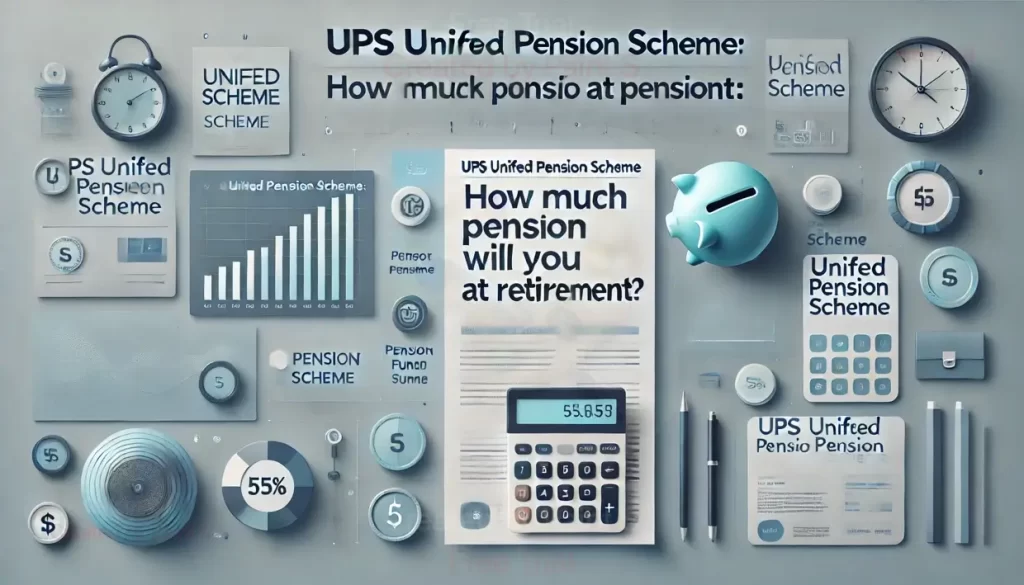Retirement planning is essential for every working individual, and schemes like the Unified Pension Scheme (UPS) aim to ensure financial security during your golden years.
However,
The UPS has introduced certain rules and limitations that have left employees concerned. In this article, we will break down the key features of the UPS in simple English and explain how much pension you can expect to receive after retirement.
What is UPS (Unified Pension Scheme)?
The Unified Pension Scheme (UPS) is a retirement plan for government employees. Under this scheme:
- Employees need to have at least **10 years of service** to qualify for a pension.
- They will receive 50% of their average salary from the last 12 months as their pension.
- If they choose Voluntary Retirement (VRS), they can only start receiving the pension once they turn 60 years old, even if they retire earlier.
- The scheme also transfers the employee’s NPS contributions to the government**, and in return, the government provides a **10% lump sum** payment every six months.
In simple terms, UPS helps employees get a pension after retirement but with certain waiting periods and conditions.
Key Highlights of the Unified Pension Scheme (UPS)

1. Eligibility for Pension
- The scheme is applicable only to employees who have completed at least 10 years of qualifying service before retirement.
- If eligible, employees will receive a monthly pension equivalent to 50% of the average salary of the last 12 months before retirement.
2. Inflation-Linked Pension
- The pension amount will include Dearness Allowance (DA) to help retirees cope with inflation.
3. Voluntary Retirement (VRS) Rules
- Employees can opt for Voluntary Retirement Scheme (VRS) only after completing 25 years of service.
- However, even after opting for VRS, the pension will be payable only when the employee reaches 60 years of age.
- For instance, if an employee retires at the age of 45 under VRS, they will have to wait 15 years to start receiving their pension.
4. Employee Contribution Adjustments
- Employees contributing to the National Pension System (NPS) will have their NPS contributions transferred to the government as part of the new scheme.
- In return, the government will pay employees 10% of their salary as a lump sum every six months.
5. Gazette Notification
- The Government of India officially released the UPS notification on the eve of Republic Day.
Read also: Bank of Japan’s Biggest Interest Rate Hike Since 2008: Will It Impact the Indian Stock Market?
Concerns Raised by Employee Organizations
The announcement of the UPS has drawn criticism from employee unions and organizations, including the National Mission for Old Pension Scheme (NMOPS). Here are the key concerns raised:
- Delayed Pension Payments: Employees believe that pension should start immediately after voluntary retirement, rather than waiting until they turn 60.
- Reduced Service Years for VRS: The demand is to reduce the mandatory service period for VRS from 25 years to 20 years, similar to the old pension schemes like the National Pension System (NPS) and Old Pension Scheme (OPS).
- Return of Contributions with Interest: Employees are requesting the government to return the employee contributions with interest, instead of paying a lump sum amount every six months.
- Disadvantage Compared to NPS: Under the NPS, employees have the flexibility to withdraw their contributions with interest. However, in the UPS, contributions are transferred to the government’s account without a clear option for withdrawal.
Read also: 12 Reason Why People Still Invest in the Stock Market If Losses Are So Common?
How Much Pension Will You Get?
The pension amount under the UPS is calculated as 50% of the average salary for the last 12 months of service. For example:
- If your average monthly salary (including allowances) in the last year of service is ₹50,000, your monthly pension will be:
₹50,000 × 50% = ₹25,000
Additionally, the pension will include Dearness Allowance (DA) to adjust for inflation.
Comparison with the National Pension System (NPS)
| Feature | Unified Pension Scheme (UPS) | National Pension System (NPS) |
|---|---|---|
| Eligibility | Minimum 10 years of service | No minimum service requirement |
| Pension Start | At the age of 60 | Immediate upon retirement |
| Employee Contribution | Transferred to the government | Invested in market-linked instruments |
| Lump Sum Withdrawal | 10% of salary paid every 6 months | Up to 60% of the corpus upon retirement |
| Voluntary Retirement (VRS) | After 25 years of service | Flexible |
Employee Demands for UPS Reform
- Reduce Service Period for VRS: Reduce Service Period for VRS: Employees demand that the qualifying period for VRS be reduced from 25 years to 20 years, in line with NPS and OPS.
- Immediate Pension Post-VRS: Pension payments should start immediately after voluntary retirement, rather than waiting until the age of 60.
- Refund Employee Contributions with Interest: Instead of transferring contributions to the government, employees prefer receiving their NPS contributions back with accumulated interest.
Read also: Exclusive: Denta Water IPO GMP Premium Up 56%, Subscribed 2x; What You Need to Know
Conclusion
The Unified Pension Scheme (UPS) aims to provide financial security to employees after retirement, but its strict conditions and delayed payouts have raised significant concerns. While it promises an assured pension of 50% of the last 12 months’ average salary, the waiting period and restrictions on withdrawals have made employees question its practicality.
For now,
Those planning their retirement under UPS should carefully evaluate the scheme’s benefits and limitations. Staying informed and voicing concerns through employee unions can help bring about the necessary reforms in the system.
If you are eligible for the UPS, ensure you plan your retirement early, keeping in mind the waiting period and contribution adjustments to make the most of the scheme.

